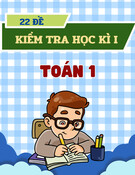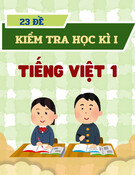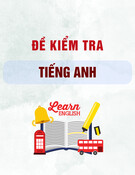
S GD&ĐT VĨNH PHÚCỞ
TR NG THPT NGUY N VI T XUÂNƯỜ Ễ Ế
MÃ Đ: 301Ề
(Đ thi g m 4 trang)ề ồ
Đ KH O SÁT CH T L NG L N 4Ề Ả Ấ ƯỢ Ầ
Năm h c 2017 - 2018ọ
Môn: Ti ng Anh 11ế
Th i gian làm bài: 60 phút (không k th i gian giao đ)ờ ể ờ ề
(Thí sinh không đc s d ng tài li u)ượ ử ụ ệ
H , tên thí sinh:..................................................................... S báo danh: .............................ọ ố
Read the following passage and mark the letter A, B, C, or D on your answer sheet to indicate the
correct word or phrase that best fits each of the numbered blanks from
1 to 5.
Keys to Health and Longevity
We hear it all the time: “Health is everything.” And while there are many actions we can take to
promote great health, we tend to overlook some of the simplest and most obvious. The first key is rooted
within your unique life purpose. Few of us actually live with a purpose. And those of us (1) _______ do
have trained our minds and bodies to want to live longer because we require time to (2) _______ our
mission. Secondly, regular physical activity improves many bodily functions and is generally just a good
way to make you feel better. (3) _______, balanced forms of enjoyable exercise can help us manage stress,
reduce anxiety, strengthen the immune system and improve sleep. It can be interesting to experiment with
different types of movement and play to see how they work for you and your body. Choosing movement
that helps create inner balance in addition to (4) _______ balance helps optimize your overall health.
Lastly, you should live a non-toxic life. Many aspects (5) _______ our homes and workplaces impact our
health, mood and energy. You want to feel safe, calm and energized in the places you spend your time.
Câu 1: A. which B. whose C. who D. whom
Câu 2: A. fulfill B. do C. finish D. implement
Câu 3: A. In contrast B. Therefore C. Additionally D. However
Câu 4: A. physically B. physical C. physics D. physicist
Câu 5: A. in B. at C. for D. of
Read the following passage and mark the letter A, B, C, or D on your answer sheet to indicate the
correct answer to each of the questions from
6 to 12.
Productivity Hacks for Great Success
No matter who we are or where we are from, we only have 24 hours each day to get things done.
Some people seem to make the most of their time, using it to achieve their goals and dreams. Others feel
that life is passing them by and they aren’t accomplishing anything. If you are in the latter group, it is not
too late to turn things around. By implementing a few simple hacks, you can start getting better results
very quickly.
If you want to become more productive, it pays to learn about the Pareto principle (which is also
known as the 80-20 rule). It states that for most tasks, 80 percent of the results we get come from 20
percent of the work we do. For example, 80 percent of the company sales usually come from 20 percent of
customers. Therefore, the trick is to focus your efforts on the key 20 percent of actions that truly matter to
greatly improve your results.
In some cases, people may be busy from morning to night but still seem to get nothing done. In this
situation, the problem might be that clear goals haven’t been set. To fix this, set some time aside to list the
things you want to achieve in life. Then, select the top three or four that you want to focus on for the next
year. Look at your goals every night before bedtime and ask yourself what are the next actions to
accomplish each day. Then, promise yourself that you will finish these tasks no matter how busy you get.
If possible try completing the tasks first thing in the morning so you are assured of success.
Another common mistake regarding productivity is not considering our energy levels. If we try to
work around the clock, we will eventually get tired and quit. Everyone needs time to sleep, eat, socialize
with friends, and unwind from the stress of the day. To make sure you don’t burn out, be sure to schedule
some time for breaks and fun activities into your schedule every day. Finally, no matter how difficult your
goals may seem, remember the old saying that “a journey of a thousand miles begins with a single step”.
Trang 1/5 - Mã đ thi 301ề

Câu 6: What is implied in the last sentence of the passage?
A. People get their best ideas when traveling. B. It is best to take a big first step.
C. Start moving toward your dreams little by little. D. Think twice before taking any steps.
Câu 7: In order to achieve our goals, we should______.
A. set the goals just before bedtime in order to remember them better
B. select the most important goals for each day and take the priority to achieve them within the day
C. set as many goals as possible so that we can achieve some of them or at least 20 percent
D. eat a lot to burn enough energy for our daily activities
Câu 8: Which of the following statements does the author support most?
A. How difficult our goals may seem, we should take steps to travel a thousand miles to achieve them.
B. We try to work around the clock and set some time aside to list the things we want to achieve in life.
C. Reasonable goals and good techniques of time management may help you get great achievements.
D. We need time to sleep, eat, socialize with friends, and achieve our goals for 20 percent of the day’s time.
Câu 9: The word “this” in paragraph 3 refers to______.
A. setting no aims B. a lack of time C. failing in business D. clear goals
Câu 10: The phrase “hacks for” in the title is closest in meaning to______.
A. secretly achieves B. kicks without control C. cuts off D. leads to
Câu 11: Which of the following sentences is true?
A. Everyone has the same time in a day. B. No one has any spare time these days.
C. Everyone manages time the same way. D. No one ever achieves all of their goals.
Câu 12: What is the Pareto principle?
A. A few important things produce most of the results.
B. If you work hard 80 percent of the time, you can relax for 20 percent.
C. You need to do lots of work to increase sales by 20 percent.
D. Companies don’t need to hire more than 80 people.
Mark the letter A, B, C, or D on your answer sheet to indicate the word that differs from the other three
in the position of primary stress in each of the following questions from
13 to 14.
Câu 13: A. energetic B. investigate C. information D. calculation
Câu 14: A. attract B. decent C. install D. approach
Mark the letter A, B, C, or D on your answer sheet to indicate the underlined part that needs correction
in each of the following questions from
15 to 17.
Câu 15: The government has had a lot of different solutions for population growth.
A. for B. different C. a lot of D. has had
Câu 16: The more intelligent he is, the more lazy he becomes.
A. more lazy B. The C. becomes D. is
Câu 17: She is such beautiful girl that everyone likes her.
A. that B. likes C. beautiful girl D. is
Mark the letter A, B, C, or D on your answer sheet to indicate the word(s) CLOSEST in meaning to the
underlined word(s) in each of the following questions from
18 to 19.
Câu 18: Although he is recognized as one of the most brilliant scientists in his field, Professor White
cannot seem to make his idea understood in class.
A. get his idea down B. summarize his idea C. recall his idea D. get his idea across
Câu 19: Many education courses require both oral and written presentations before degrees are awarded.
A. prepared B. spoken C. excellent D. understood
Mark the letter A, B, C, or D on your answer sheet to indicate the word whose underlined part differs
from the other three in pronunciation in each of the following questions from
20 to 21.
Trang 2/5 - Mã đ thi 301ề

Câu 20: A. throne B. mathematics C. thank D. bother
Câu 21: A. indulge B. burial C. structure D. undertake
Mark the letter A, B, C, or D on your answer sheet to indicate the sentence that is closest in meaning to
each of the following questions from
22 to 24.
Câu 22: Mary said “I am awfully sorry that I have made a silly mistake.”
A. Mary apologized with me for having made a silly mistake.
B. Mary apologized to me for having made a silly mistake.
C. Mary was sorry that she has made a silly mistake.
D. Mary apologized to have made a silly mistake.
Câu 23: Having spent all his money, Daniel couldn’t afford a new watch.
A. As Daniel had bought a new watch, he spent all his money.
B. Because he had spent all the money, Daniel couldn’t afford a new watch.
C. Daniel couldn’t get a new watch because he didn’t have much money.
D. Danile didn’t buy a new watch although he had a lot of money.
Câu 24: You put a paper on fire, it burns quickly.
A. When you put a paper om fire, it will burns quickly. B. When a paper is put on fire, it burns quickly.
C. If a paper was put on fire, it burns quickly. D. If you will put a paper on fire, it burns quickly.
Mark the letter A, B, C, or D on your answer sheet to indicate the word(s) OPPOSITE in meaning to the
underlined word(s) in each of the following questions from
25 to 26.
Câu 25: I am glad that we see eye to eye on the matter of the conference location.
A. approve B. agree C. dislike D. disagree
Câu 26: It is widely known that the excessive use of pesticides is producing a detrimental effect on the
local groundwater.
A. fundamental B. useless C. harmless D. damaging
Mark the letter A, B, C, or D on your answer sheet to indicate the sentence that best combines each pair
of sentences in the following questions from
27 to 28.
Câu 27: She buys a lot of new dresses every month. She always dresses shabbily.
A. She always dresses shabbily although she buys a lot of new dresses.
B. However a lot of new dresses she buys every month, she always dresses shabbily.
C. Many as new dresses she buys every month, she always dresses shabbily.
D. However many new dresses she buys every month, she always dresses shabbily.
Câu 28: The director guided us through the museum. He gave us a specific explanation.
A. The director guided us through the museum and was giving us a specific explanation.
B. Guiding us through the museum, a specific explanation was given to us by the director.
C. The director guided us through the museum while a specific explanation was given to us.
D. While the director was guiding us through the museum, he gave us a specific explanation.
Mark the letter A, B, C, or D on your answer sheet to indicate the correct answer to each of the
following questions from
29 to 40.
Câu 29: If you use solar water heaters in your home, you ______ your carbon footprint.
A. reduce B. would have reduced C. are reducing D. would reduce
Câu 30: You’d better cut ______ animal fat if you want to lower your cholesterol level.
A. down on B. off with C. down with D. out in
Câu 31: Many of the ______ not used today. They are remnants of the past.
A. railroad tracks around here are B. railroad tracks around here is
C. railroad’s tracks around here is D. railroad’s tracks around here are
Câu 32: When his business failed, he started again from ______.
A. beginning B. introduction C. scratch D. balnk
Câu 33: His former teacher ______ him against swimming too far.
A. advised B. suggested C. wanted D. warned
Trang 3/5 - Mã đ thi 301ề

Câu 34: Up ______ when it saw its master.
A. does the dog jump B. the dog jumped C. jumped the dog D. did the dog jump
Câu 35: John said if he ______ any money he ______ me a drink.
A. has had/ would buy B. had/ would have bought
C. had had/ would have bought D. has/ will buy
Câu 36: No one died in the accident, ______?
A. did they B. didn’t they C. did he D. didn’t he
Câu 37: The teacher punishes anyone ______ the rules.
A. breaking B. broke C. breaks D. to break
Câu 38: Planning trees can ______ reduce global warming.
A. significantly B. signify C. significant D. significance
Câu 39: The type of plant and animal life living in and around a pond depends on the soil of the pond,
______, and the pond’s location.
A. what is the water quality B. how is the water quality
C. the quality of the water D. what the quality of the water is
Câu 40: The city has ______ of young consumers who are sensitive to trends, and can, therefore, help
industries predict the potential risks and success of product.
A. a high tendency B. a high rate C. a great level D. a high proportion
Read the following passage and mark the letter A, B, C, or D on your answer sheet to indicate the
correct answer to each of the questions from
41 to 48.
Carbon dating can be used to estimate the age of any organic natural material; it has been used
successfully in archeology to determine the age of ancient artifacts or fossils as well as in a variety of other
fields. The principle underlying the use of carbon dating is that carbon is a part of all living things on
Earth. Since a radioactive substance such as carbon-14 has a known half-life, the amount of carbon-14
remaining in an object can be used to date that object.
Carbon-14 has a half-life of 5,570 years, which means that after that number of years, half of the
carbon- 14 atoms have decayed into nitrogen-14. It is the ratio of carbon-14 in that substance that indicates
the age of the substance. If, for example, in a particular sample the amount of carbon-14
is roughly equivalent to the amount of nitrogen-14, this indicates that around half of the carbon-14 has
decayed into nitrogen-14, and the sample is approximately 5,570 years old.
Carbon dating cannot be used effectively in dating objects that are older than 80,000 years. When
objects are that old, much of the carbon-14 has already decayed into nitrogen-14, and the molecule amount
that is left doesn’t provide a reliable measurement of age. In the case of older objects, other age-dating
methods are available, methods which use radioactive atoms with longer half-lives than carbon has.
Câu 41: This passage is mainly about______.
A. the differences between carbon-14 and nitrogen-14 B. various uses for carbon
C. archeology and the study of ancient artifacts D. one method of dating old objects
Câu 42: Which of the following is NOT true about carbon-14?
A. It and nitrogen always exist in equal amounts in any substance.
B. Its half-life is more than 5,000 years.
C. It is radioactive.
D. It can decay into nitrogen-14.
Câu 43: The word “it” in paragraph 1 refers to______.
A. any organic natural material B. carbon dating C. archeology D. the age
Câu 44: The word “underlying” could best be replaced by______.
A. serving as a basis for B. requiring C. below D. being studied through
Câu 45: The word “roughly” in paragraph 2 is closest in meaning to______.
A. harshly B. precisely C. coarsely D. approximately
Câu 46: The paragraph following the passage most probably discusses______.
A. why carbon-14 has such a long half-life B. various other age-dating methods
C. what substances are part of all living things D. how carbon-14 decays into nitrogen-14
Trang 4/5 - Mã đ thi 301ề

Câu 47: It is implied in the passage that______.
A. fossils cannot be age-dated using carbon-14
B. carbon dating has no known uses outside of archeology
C. carbon dating could not be used on an item containing nitrogen
D. carbon-14 does not have the longest known half-life
Câu 48: It can be inferred from the passage that if an item contains more carbon-14 than nitrogen-14, then
the item is______.
A. too old to be age-dated with carbon-14 B. more than 5,570 years old
C. not as much as 5,570 years old D. too radioactive to be used by archeologists
Mark the letter A, B, C, or D on your answer sheet to indicate the most suitable response to complete
each of the following exchanges from
49 to 50.
Câu 49: – Minh: “ My first English test was not as good as I expected.” - Thomas: “______”
A. It’s okay. Don’t worry. B. That’s brilliant enough!
C. Never mind, better job next time! D. Good Heavens!
Câu 50: Ken and Tom are high school students. They are discussing where their study group will meet.
Select the most suitable response to fill in the blank.
- Ken: “Where is our study group going to meet next weekend?” - Tom: “______”
A. Studying in a group is great fun. B. The library would be best.
C. We are too busy on weekdays. D. Why don’t you look at the atlas?
----------- H T ----------Ế
Trang 5/5 - Mã đ thi 301ề






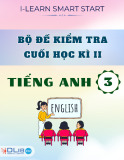
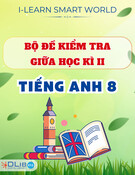
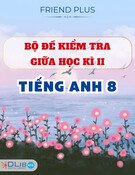
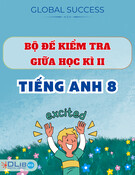
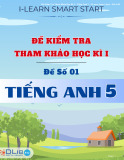

![Đề thi Tiếng Anh có đáp án [kèm lời giải chi tiết]](https://cdn.tailieu.vn/images/document/thumbnail/2025/20250810/duykpmg/135x160/64731754886819.jpg)
